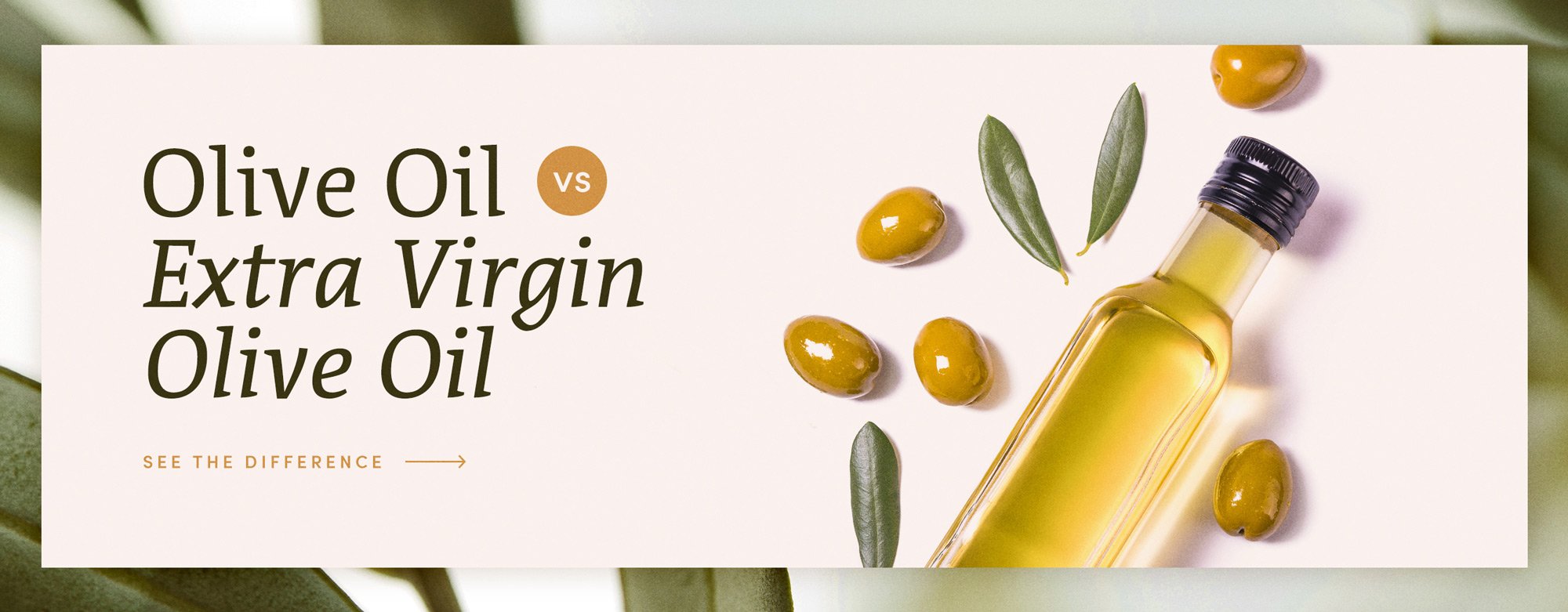Olive Oil vs Extra Virgin Olive Oil: What’s the Difference?
Last updated on Mar 5, 2024Janine JonesOlive oil is a staple of Italian cuisine and a foundational ingredient in many recipes, like pasta sauces and pizza. With the various types of olive oil available, you might be asking yourself, “what is the difference between olive oil and extra virgin olive oil? Is there one?” We explored the olive oil differences to help you make an educated shopping decision and find the right olive oil for your recipes.
Shop All Olive OilWhen to Use Olive Oil vs Extra Virgin
From drizzling on salad to sauteeing, there is a type of olive oil for each cooking application. Watch our video to discover the differences between olive oil varieties and when to use each.
What Is Olive Oil?
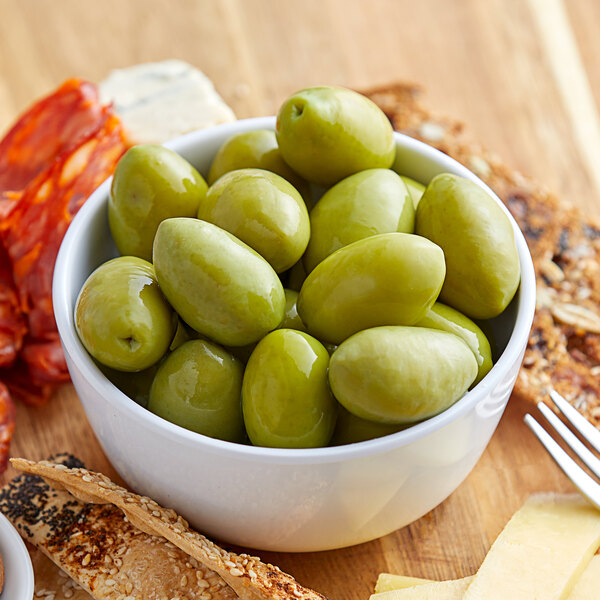
In its purest form, olive oil is oil that is released when the fruits of olive trees are pressed. That liquid can then be filtered and refined to create cooking oil, salad oil, and dips. There are various types of olive oil based on the process used to extract the oil, its additives, and free oleic acid levels (a naturally occurring fatty acid). The most common olive oil types, also known as olive oil grades, are plain or regular olive oil, virgin olive oil, and extra virgin olive oil. Each can vary slightly in taste, color, and oleic acid level.
What Does Olive Oil Taste Like?
Olive oil typically has a neutral, earthy, but herbal flavor, ranging from slightly fruity to bitter. The taste of olive oil will depend on the grade, the region where the olives are grown, and the manufacturer. Olive oil flavor profiles can vary like one would expect when tasting wine, with a range of aromas and complexities. In general, extra-virgin olive oil is zestier and more flavorful than plain olive oil.
Uses for Olive Oil
Here are just some olive oil uses you can try:
- To saute and fry food
- As a bread baste
- In salad dressing
- As a pasta sauce
- For bread dips
- As a butter substitute in dairy-free baked goods
Refined vs Unrefined Olive Oil
The difference between refined and unrefined olive oil is that unrefined olive oil stays in its purest state while refined oil is heated and filtered to remove any visual flaws. Extra virgin olive oil undergoes little to no refinement in order to keep its bold flavors and color. As olive oil is refined, it will lose some of its aroma while lightening in color and flavor. It also loses some of its antioxidants and anti-inflammatory properties.
What Is Extra Virgin Olive Oil?
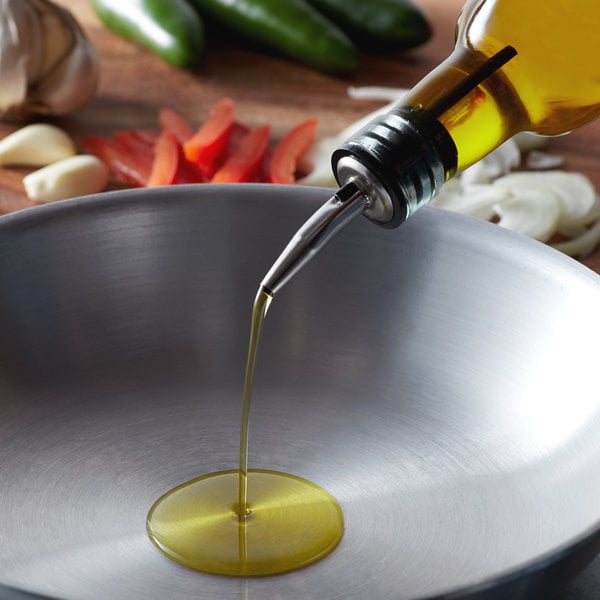
Extra virgin olive oil is olive oil that is unrefined, allowing it to retrain its full flavor profile and nutritional properties. It is typically golden-green in color and has a light peppery flavor. It is made by grinding olive fruits and pressing the paste to extract the oil. To be considered extra-virgin olive oil, the oil cannot be treated with chemicals or heat during the expression and bottling process. When olive oil is heated, the fats break down and increase the free oleic acid, which reduces its nutritional value.
Extra-virgin olive oil needs to contain no more than 1% free oleic acid to maintain its distinction. For integrity, oil cultivators must cold-press the olives to keep the oil from heating. Extra virgin olive oil is considered a healthy alternative to other oils, such as canola oil and sunflower oil, because it is rich in natural vitamins, minerals, and antioxidants that haven’t been filtered out.
There are some concerns with the authenticity and purity of extra virgin olive oil in the agricultural industry. Those looking to make a quick buck off of the demand for extra virgin olive oil have been known to blend in other oil varieties to extend the reach of their product. To ensure that you are getting a true unadulterated product, look for where the product was made. Italian producers in Sicily or Puglia are known for protecting the authenticity and integrity of their olive oils from start to finish.
What Does Extra Virgin Olive Oil Taste Like?
Extra virgin olive oil is herbal and peppery in flavor, occasionally described as spicy and pungent. The flavor profile will vary depending on the olives, when they were grown, and where they were harvested. The reduced levels of oleic acid allow the natural flavors of the olive fruit to shine through in this unadulterated oil.
Uses for Extra Virgin Olive Oil
Extra virgin olive oil has a lower smoke point than most oils, meaning that it is prone to burning at high temperatures. Because of this and its complex flavor profile, it is not the ideal choice for cooking or frying. Here are some other extra virgin olive oil uses to try instead:
- Dips for bread
- Salad dressing
- Cold pasta salads
- Drizzled on vegetables
- Spread on focaccia and olive bread
Olive Oil vs Extra Virgin Olive Oil
The difference between extra virgin and olive oil is that regular olive oil is heated to extract the oil and refined while extra virgin olive oil is cold-pressed and left unrefined. Extra virgin olive oil is usually stronger in flavor and darker in color than regular olive oil. While regular olive oil is excellent for cooking and frying, extra virgin olive oil has a lower smoke point and is best for non-heated applications so that its complex flavor can be properly appreciated.
What Is Virgin Olive Oil?
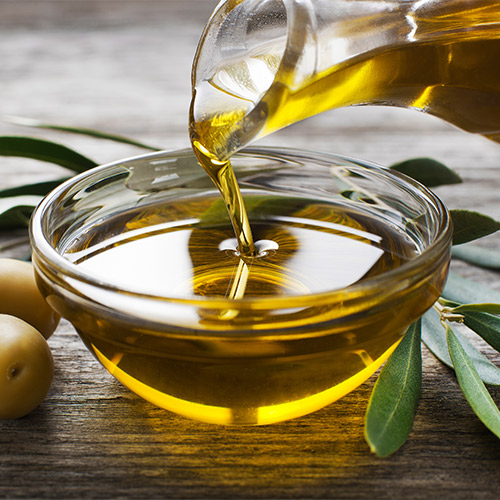
Virgin olive oil is olive oil that is unrefined and cold-pressed but does not undergo the strenuous qualifications to certify it as extra virgin olive oil. It is typically golden in color with a fruity and herbal aroma and flavor. The free oleic acid levels of virgin olive oil are not held to the strict standard of less than 1% like that of its extra virgin counterpart, therefore making it a medium-grade option. Because it does not have the certification of distinction, virgin olive oil is not often found on store shelves.
What Does Virgin Olive Oil Taste Like?
Virgin olive oil has an herbal almost fruity flavor with mild zestier notes. The flavor is more potent than that of regular olive oil but less pronounced than that of extra virgin olive oil.
Uses for Virgin Olive Oil
Because virgin olive oil retains some of its flavor complexities, it is perfect for when you want a bold flavor without the added price tag.
- Roasting vegetables
- Grilling meat
- Crisping pizza crust
- Preparing pasta salad
- Drizzling on salad greens
Extra Virgin vs Virgin Olive Oil
Virgin olive oil is pressed and processed in a similar cold-pressing method as extra virgin olive oil, except its purity is not as rigorously monitored and, therefore, doesn’t earn it the title of extra-virgin. Extra virgin olive oil is also usually darker in color with a greener hue and stronger in flavor with more peppery notes.
Olive Oil vs Virgin Olive Oil
The difference between olive oil and virgin olive oil is that regular oil is refined, heated, and filtered while virgin olive oil is mostly unrefined and cold-pressed to extract the oil. Regular olive oil is much lighter in color and flavor than virgin olive oil, and it is better suited for cooking applications where the flavor of the oil is not an essential piece of the recipe.
Which Olive Oil Is Best for Cooking?
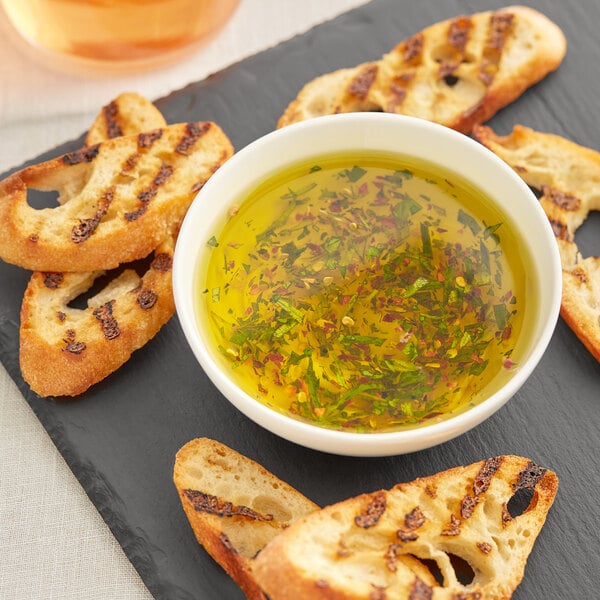
In cooking and frying applications, the best olive oil to use is original or regular olive oil. Olive oil is an excellent oil for frying because it is high in monounsaturated fats, a healthier alternative to polyunsaturated fats. While you can use extra virgin olive oil for cooking, the heat will break down the fat molecules, reducing its nutritional benefits and the rich flavor won’t be able to be as appreciated in a heated dish.
Allow your extra virgin olive oil to shine in cold dishes where the flavors are the centerpiece of the recipe. If you’re asking yourself, “can I use regular olive oil instead of extra virgin in cold recipes?” The simple answer is yes, but your guests would be missing out on a memorable culinary experience created by the complex flavor profile of extra virgin olive oil. If you’re looking for a middle ground between versatility and flavor, reach for virgin olive oil.
With the various brands, colors, and types of olive oil on store shelves, it can be overwhelming to choose one for your recipes. Olive oils can look and taste distinctly different from brand to brand so you may need to test some options before making your selection. Use this resource to help guide your next shopping trip and find the right olive oil for your menu.
